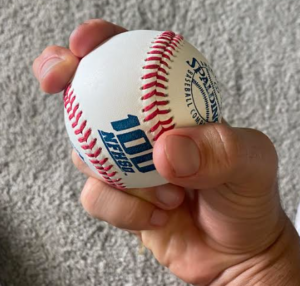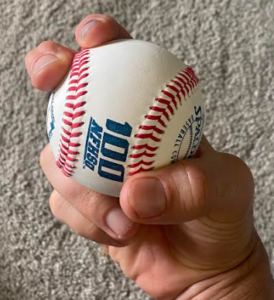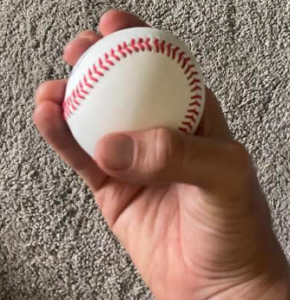Throwing curveballs takes years of practice to perfect, with wide ranges of spin rates, grips, and movement on the ball.
What’s better than leaving a hitter frozen at the plate on a nice sharp deuce? Not much if you ask me.. why is why the curveball was my favorite pitch to throw!
Let’s take a look at the best ways to throw a curveball, as well as how some of the best of all time threw this popular offspeed pitch.
Contents
6 popular Curveball Grips
Traditional Curveball Grip
This standard curveball grip is shown in the picture above, and it involves using your middle finger along the curve of the horseshoe seam with your index finger right next to it.
The thumb placement on curveballs differs for pitchers depending on their hand size and what’s most comfortable for them.
Some pitchers like to have the thumb resting on the bottom seam, while others tuck it under the ball to use for balance.
Knuckle Curve Grip
The knuckle curve grip is another curveball grip you will likely only see used at the advanced levels of baseball.
Pitchers with big hands sometimes feel like the knuckle curve can help them generate even more spin than the traditional curveball grip.
The knuckle curve is held deeper in the hand, and the index finger is typically raised and pinching down on the seem while the middle finger is placed in the same place as the traditional curveball.
Knuckle curves were always difficult for me to throw when I experimented with them, but I knew several pitchers that loved throwing them.
Split Seam Curveball Grip
The split seam curveball grip is another niche grip that was my personal favorite type of grip to throw.
The split seam grip enabled me to focus on using my thumb and palm below my thumb to generate a nice 12-6 spin, and it felt natural coming out of my hand.
I also could generate more spin on the ball with my index finger compared to my middle finger, which is why I preferred having my index finger on the seam instead.
I liked to have my thumb resting on the bottom seam and use my thumb and index fingers as the primary drivers to generate spin.
As you can see in the photo above, my index finger and thumb split the ball in half on both seams, and the second photo shows my thumb placement as I begin to rotate the ball toward home plate.
Youth Baseball Grip
Many youth baseball coaches don’t want young players throwing curveballs because they feel like they can potentially hurt their arms doing so.
Younger pitchers aren’t as coordinated, and they do have tendencies to try and yank their arms and try and generate spin.
This can result in arm injuries if players twist their arms too aggressively. One grip that avoids twisting your wrist or arm much is the football grip.
The football grip will not break nearly as much as the grips mentioned below, but the goal is to have a secondary pitch for youth players to keep hitters off balance.
This grip will generate a small bit of downward spin and get younger pitchers learning the foundations of how to execute a curveball as their bodies develop.
What age can kids start throwing curveballs?
There are various opinions on the recommended ages when kids should start throwing curveballs. Because kids develop at different timeframes, the answer differs from kid to kid.
It’s not the curveball that can hurt a kid’s arm; throwing it the wrong way is the problem.
I have had physically mature kids around 10 years old be capable of using good mechanics and body control to throw a curveball. Still, most of them typically average around 11-12 years old.
The football grip mentioned above is a good introduction for younger players to start to learn the fundamentals of throwing a curveball and trying to generate a downward spin.
You want to make sure young players aren’t trying to jerk their arms or elbows in a herky-jerky motion and instead keep their wrists stiff and focus on generating spin from their fingers and grip.
Curveball Movement
Curveball grips vary from pitcher to pitcher depending on hand size, arm slot, and comfort level. Here are the most common types thrown:
12-6 Curveball
Adam Wainwright, Pretty 73mph Curveball. 🌈 pic.twitter.com/EKFgmncH7U
— Rob Friedman (@PitchingNinja) August 18, 2022
The 12 6 curveball is a curveball that drops straight down from the 12 o’clock position to the 6 o’clock position.
Most pitchers throw across their body in some form, so you will see a 11-5 curveball more frequently then you would see a 12-6 curveball.
Adam Wainright has one of the best 12 6 curveballs in MLB history and has a long successful career because of his 12-6 breaking ball.
Despite a below-average fastball, his plus 12-6 breaking ball is so good that he has been pitching since 2005 and continues to keep hitters off balance with the pitch.
12-6 Release Point
Most pitchers tend to release their curveballs too early or twist their wrists to try and generate a downward spin on the baseball.
It’s very difficult to throw a 12-6 curveball if you’re releasing the ball too early or twisting your wrist diagonally.
October 11, 1998
— NY Yankees Throwbacks (@yankeethrowback) January 4, 2023
David Wells strikes out 11 and gets the win in ALCS Game 5 pic.twitter.com/Y8ubcScDNL
One of my favorite pitchers growing up was David Wells, who had a nasty 12-6 curveball.
When I was a kid, he gave an interview about how he threw his curveball, and the light ball went off for me.
He explained that when he threw his curveball, he maintained the exact same intensity as when he threw his fastball, and the only differences for him were his grip and his release point.
He kept the same arm action as when he threw his fastball and described when he got close to his release point, he envisioned pulling a light switch with his fingers and wrist.
This small movement helped generate a sharp 12-6 spin with high intent, which gave Wells one of the best 12-6 breaking balls in MLB history.
If you struggle with throwing 12-6 curveballs, practice throwing it during flat ground sessions or while you warm up and emphasize maintaining the same arm angle as your fastball and releasing the curveball out front as you would with your fastball.
11-5 Curveball for Lefties/1-7 for Righties
Steven Matz, Wicked 78mph Curveball. 🤢 pic.twitter.com/jeM7WLZrqG
— Rob Friedman (@PitchingNinja) June 12, 2021
The 11-5 rotation curveball is the most common type of curveball for lefties while you will typically see a 1-7 rotation for righties. Not everyone has the arm angle to be able to throw a 12-6 curveball, so an 11-5 or 1-7 rotation is often the more natural movement many get on the ball.
Slurve
Kluber saw the Michael King had the same release point as him so he taught him his Kluberball (slurve) pic.twitter.com/Zz5y06Y0f4
— Jomboy (@Jomboy_) September 29, 2021
The slurve is a hybrid pitch of a curveball and slider combined together. The slurve is thrown harder than a traditional curveball and not as hard as a typical slider.
Curveball Velocity
Curveball velocities at the MLB level is typically between 70-80 MPH, and they have been ticking higher toward 80 MPH over the last decade.
Pitchers are throwing their curveballs harder than ever as hitters have gotten more athletic and can pick up slow-breaking balls easier out of the hand.
Here is a look at the last 10 years of average MLB curveball velocities according to Fangraphs.
|
Year |
Average MLB Curveball Velocity |
|
2022 |
79.1 |
|
2021 |
78.7 |
|
2020 |
78.4 |
|
2019 |
78.5 |
|
2018 |
78.2 |
|
2017 |
77.9 |
|
2016 |
77.6 |
|
2015 |
77.7 |
|
2014 |
77.1 |
|
2013 |
76.8 |
|
2012 |
76.6 |
Backdoor Curveball
This Jonathan Loaisiga backdoor curveball was INSANE 🤮 pic.twitter.com/bakKKy7KSJ
— Talkin’ Yanks (@TalkinYanks) April 10, 2021
A backdoor curveball is a curveball that a right-handed pitcher throws to a left-handed hitter or a left-handed pitcher to a right-handed hitter that is thrown on the outside part of the strike zone.
The “backdoor” description means that the ball typically starts out of the strike zone and curves back into the strike zone for a called strike.
A good backdoor curveball is very difficult to hit but, at the same time, is hard to throw! If you leave, let a backdoor curveball curve back over the heart of the plate the pitch may get crushed.
Hitters have a common phrase: “You hang it, we bang it” meaning that hanging curveballs will get hit hard and that are left over the middle of the plate.
9 Tips top to help find your best curveball possible
1. Experiment with grips
Like most pitches, the best way to get comfortable with throwing a curveball is by experimenting with different grips.
Just because one of the top pitchers on your team throws a great knuckle curve doesn’t mean that you have the same hand size and ability to throw the exact same pitch.
Some pitchers have more of a three-quarters arm slot, making the slider a more natural breaking pitch.
The key is to experiment with everything; a 12-6, 11-5, slurve, and slider to find the best possible breaking pitch for your body type.
2. Keep a stiff wrist
Many pitchers make the mistake of trying to twist their wrists aggressively to generate spin on their curveballs.
Your index finger, middle finger, and thumb are the main drivers of generating spin on the ball, and the more you can rely on your fingers and palm to generate the sharp downward spin.
Here’s a good video breakdown on how to do so:
8:10 mark
3. Throw it while warming up
Once you have found your ideal grip for your changeup, make sure you throw it frequently to build muscle memory.
My favorite time to practice my changeup was while I was warming up with my throwing partner.
Use your warmup time as experimentation time to find your curveball’s perfect grip, spin rate, and velocity.
Gauge feedback from your throwing partner on which version is harder to catch than others and build off of that.
4. Practice it during flat ground
Despite the curveball evolving into more of a power-breaking pitch recently, the curveball is still a feel pitch out of your fingers and hand.
Practice throwing your curveball during flat ground work and touch and feel throwing sessions where you aren’t throwing the ball at full speed.
This will help you slow down your mechanics and work on your release point and spin coming out of your hand.
5. Experiment with speed (throw multiple versions)
Some of the best curveball pitchers I knew had different versions of their curveball that they threw at different times during a game.
For instance, many pitchers threw a 0-0 curveball much differently than they threw their 0-2 curveball.
A “get-over” curveball is a curveball that is thrown for a strike when the hitter isn’t expecting it, like a 0-0 or 2-0 count.
Locating a curveball in hitters’ counts is a great way to keep great hitters off balance.
At the same time, when you have the count in your favor, like 0-2 or 1-2, you want to try and throw a more aggressive version of your curveball in hopes of getting the hitter to chase it out of the zone and result in a strikeout or poorly batted ball.
6. Evaluate spin rate
If you have the capability to evaluate your curveball spin rate using advanced tracking metrics, these tools can help you see what velocity and spin rate is getting the most movement on the ball. Diamond Kinetics makes an affordable version of a pitch tracking system, while companies like Trackman offer a more extensive platform.
Many indoor baseball facilities throughout the country have these types of tracking tools in-house, and scheduling a session to get tracked can give you deeper insights into your breaking ball.
7. Evaluate hitter’s reactions
Another great way to evaluate how your curveball is performing against live hitting. During intrasquad games, if hitters are teeing off on your breaking balls, that isn’t a great sign that your curveball is working as it should.
If you struggle with one form of your breaking ball, try out another like a slurve, or even move to a slider if you struggle with controlling a curveball. The goal with the entire family of breaking pitches is to keep hitters off balance and develop an outpitch for yourself in favorable pitching counts.
8. Get Feedback from teammates
Your own teammates can provide feedback on what is and isn’t working as a pitcher. It’s important to develop a good relationship with your catcher and have him be on your side as a pitcher.
Your catcher has the best view of anyone of your pitches, and it’s important to ask him for feedback on how your curveball looks from behind the plate.
Best Curveballs in MLB history
Barry Zito
Barry Zito, Curveball. pic.twitter.com/GWkzcE5Nwr
— Rob Friedman (@PitchingNinja) January 14, 2021
Barry Zito had one of baseball’s best 12-6 over-the-top curveballs while pitching for the Athletics and Giants. Zito lost his zip on his fastball early in his career but used his curveball and changeup to keep hitters off balance from the left side.
Josh Beckett
20 seconds of why Josh Beckett was nasty. Operated primarily fastball/curveball, was blowing doors off at a time when not too many starters could sit 94-97. Check out the pitches at 8 and 11 seconds in to see how you can pair a high fastball with a freeze pitch curveball pic.twitter.com/Xb20qc3tGm
— Matt Daniels (@MattD_Official) December 3, 2017
Beckett was dominant in the early 2000s from the right side and had a hard curveball that was lethal as an out pitch:
Clayton Kershaw
20 seconds of why Josh Beckett was nasty. Operated primarily fastball/curveball, was blowing doors off at a time when not too many starters could sit 94-97. Check out the pitches at 8 and 11 seconds in to see how you can pair a high fastball with a freeze pitch curveball pic.twitter.com/Xb20qc3tGm
— Matt Daniels (@MattD_Official) December 3, 2017
Kershaw has won 4 Cy Youngs throughout his career in large part because of his big breaking ball. Kershaw locates the pitch on both sides of the plate from the left side and continues to keep hitters off balance
Sonny Gray
Sonny Gray, Filthy Curveball. 😷 pic.twitter.com/Eqq3XmMdae
— Rob Friedman (@PitchingNinja) April 3, 2022
Sonny Gray is an athletic RHP that is only 5’10 but has one of the best curveballs in baseball with hard downward movement.
Roy Holladay
Roy Halladay, Curveball Movement. pic.twitter.com/W2DlyjgTqb
— Rob Friedman (@PitchingNinja) February 11, 2018
Roy “Doc” Holladay was another one of the greats from the early 2000s while pitching for the Blue Jays and Phillies. Halladay had a great curveball that he used to help him become one of the best starters of his era.
Nolan Ryan
147 Seconds of Nolan Ryan DESTROYING hitters with his Curveball. 😳 pic.twitter.com/TpuF4mm9Zp
— Rob Friedman (@PitchingNinja) December 28, 2022
Nolan Ryan had one of the best fastballs in Major League history, but he also threw one of the best breaking balls as well.
Dwight Gooden
Roy Halladay, Curveball Movement. pic.twitter.com/W2DlyjgTqb
— Rob Friedman (@PitchingNinja) February 11, 2018
Dwight Gooden was one of the filthiest pitchers in the 1980s and relied heavily on his big breaking balls to become one of the best pitchers of his era.
FAQ
What’s the difference between a Slider vs a Curveball?
A slider is thrown harder than a curveball and typically has a hard lateral break, while a curveball is thrown slower and has more downward 12-6, 11-5 action on the ball. Most pitchers will typically rely on one of these breaking pitchers or the other based on what is most comfortable for their arm slot.
What are the nicknames for curveballs?
Uncle Charlie, deuce, and number two are the most common nicknames for curveballs. The number 2 is the typical hand signal catchers use to indicate throwing a curveball to pitchers, which is why the word “deuce” is commonly used on TV.
Final word
Mastering a curveball ultimately comes down to each pitcher putting in the work to determine the best grip, arm angle, and release point for their body.
No two pitchers are built the same, and like all other types of pitches, mastering your offspeed stuff takes dedication, focus, and repetition.
Hopefully, this article gave you some tips and ideas on how some of the best pitchers in MLB history have successfully executed their curveballs.




